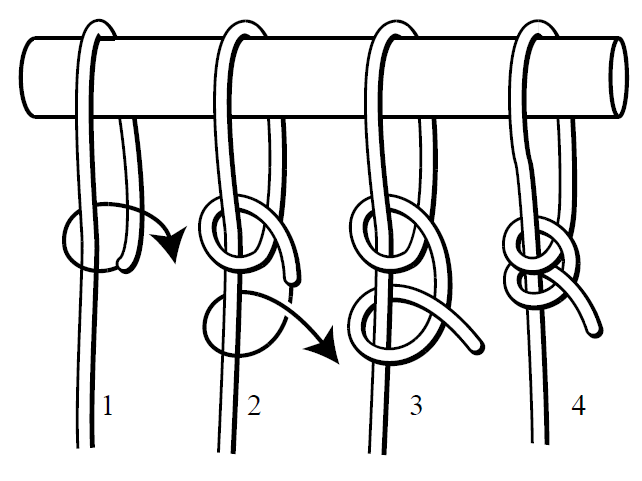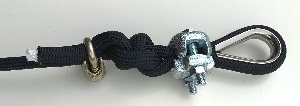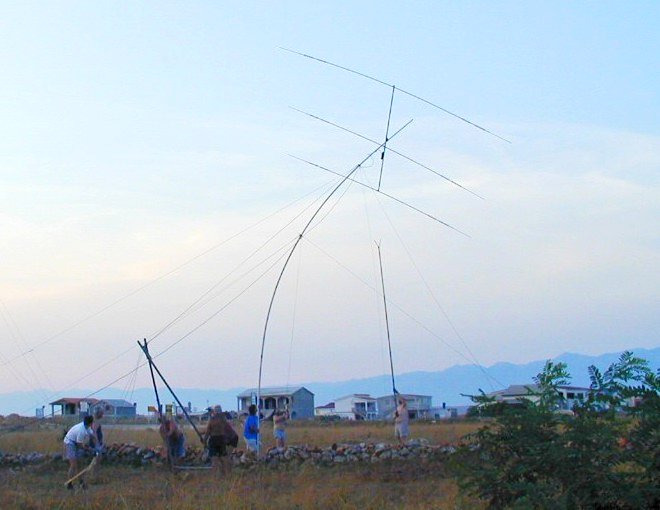When planning an “anchoring system” (guy-ropes with end termination, couplers and anchorage) there are a number of facts that have to be taken into account:
- The stability of the system is determined by its weakest link. That is why it is no use combining a rope of 5000 kg of strength with a turnbuckle 500 kg strong.
- Even the most excellent synthetic rope is elastic – when guyed it elongates. In the layout of the tower and its anchorage (even when fixing elements of the antennas) you have to reckon with this characteristic and always consider how the elongation of the anchoring system will affect the overall construction. In certain cases it will be necessary to use a stronger rope (with a smaller absolute extensibility), than for other constructions that are not negatively affected by the elongation of the anchors. A problem occurs especially in such a case, when the ground anchor point is situated too close to the tower base, or when dealing with a lattice tower with low flexibility.
- The rope must be screened against all kind of sharp edges. For this reason it is necessary to fix the rope with a thimble or tie it to a coupler with a very smooth surface. Be aware of the fact that inappropriate metallic materials corrode and therefore their surface roughens. Never should you tie a rope to a concrete slope or to a stone! If you do want to use a stone, a rock or a concrete slope as ground anchor point, we recommend using a loop from steel rope, which you can connect to the guy rope with the help of a smooth coupler.
- A great danger for any synthetic rope lies in friction against any object on its path. This can cause the rope to be seriously damaged or cut through, and has to be avoided at all cost. Even a guy rope on a tower can move enough to suffer friction damage if it touches anything along its length, so please locate your guys carefully. Particularly to be avoided are trees and tree branches. If you use tree support for a wire antenna, you must ensure that no part of the synthetic rope can get close enough to the tree to risk damage by rubbing. Always use steel rope near or in a tree. You could use a pulley on the end of a steel rope to keep the synthetic rope well clear.
- The lower part of the anchoring system can consist of steel rope cord in 2-4 meters of length. This ensures that the synthetic rope isn’t “chewed up” by an animal or gets damaged by some human activity (intentionally or unintentionally).
A key element of safety is the end termination of the rope:
- Guy ropes can be terminated with a thimble (permanent installation) or they can be tied to a smooth object.

- When fastening a rope by tying, we recommend making sure the rope does not move on the object it is tied to (even though we are talking about smooth fastening points). This can be achieved by tying the rope to a coupler – chain quick-acting coupler, spring hook or shackle – and only then fix it to the fastening point.
 We recommend Quadruple Half-hitch - it is the same as Double Half-hitch on following picture but four hitches.
We recommend Quadruple Half-hitch - it is the same as Double Half-hitch on following picture but four hitches.
- Each thimble must be followed by a clip or swaged fitting. We recommend duplex wire rope clips or fist-grips (also called Deka). Behind the main clip (the one that follows the thimble) the loose end of the rope must be fixed by the knot (we recommend Double Half-hitch). Further, the end of the loose rope is insured against uncurling for example with a cable tie or bull-dog grips for thick ropes.


- Other possibility is using crimped terminals (swaged “clips”). Those are only practical on one end of the rope – otherwise it is not possible to adjust the length. We sell them as “Ready-made" or “Terminated” guyropes - here.

- When guyed, a rope’s diameter decreases and therefore it loosens inside the clip. For this reason, clips must be drawn up while the rope is guyed, that is “under pressure”.
- Beware of classic bull-dog grips! These rope clips are constructed specially for steel ropes and when under high tension they can “snip off” synthetic ropes. In no case do we recommend using them as main clips for the end termination of ropes – they may be used as “safety clips” behind the main clip, however.
Most common mistakes and accident causes:
- The anchor point is situated too near to the tower base and that is why the angle between the guy rope and the tower equals much less than 45 degrees.
- The clips weren’t re-tightened while the rope was under tension.
- Behind the clips there is no safety element (second clip, knot).
- The end of the rope is not terminated with a thimble, but tied directly to the construction.
- The rope was chewed through by an animal or cut through.
- In the following case there was used improper rope with high elongation.


